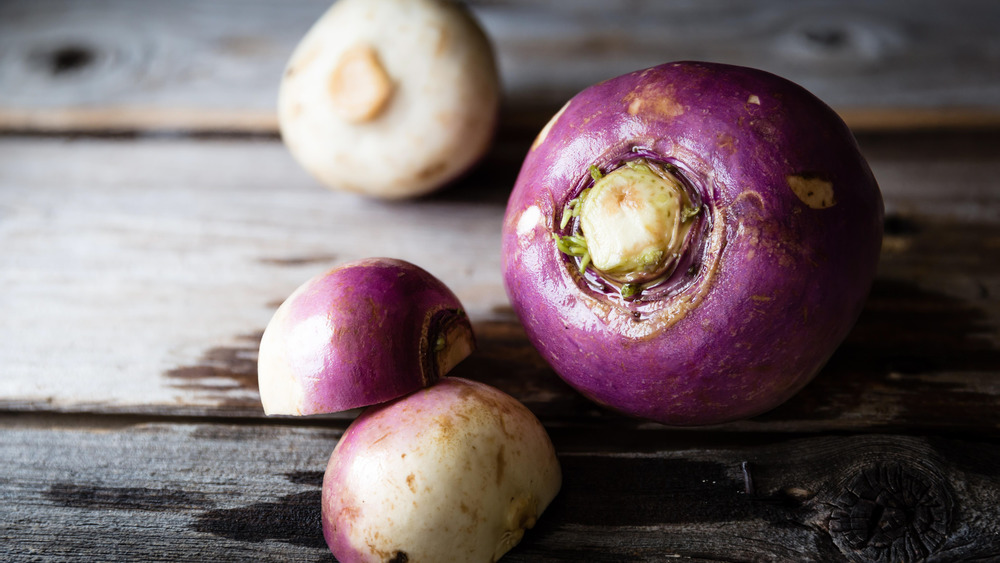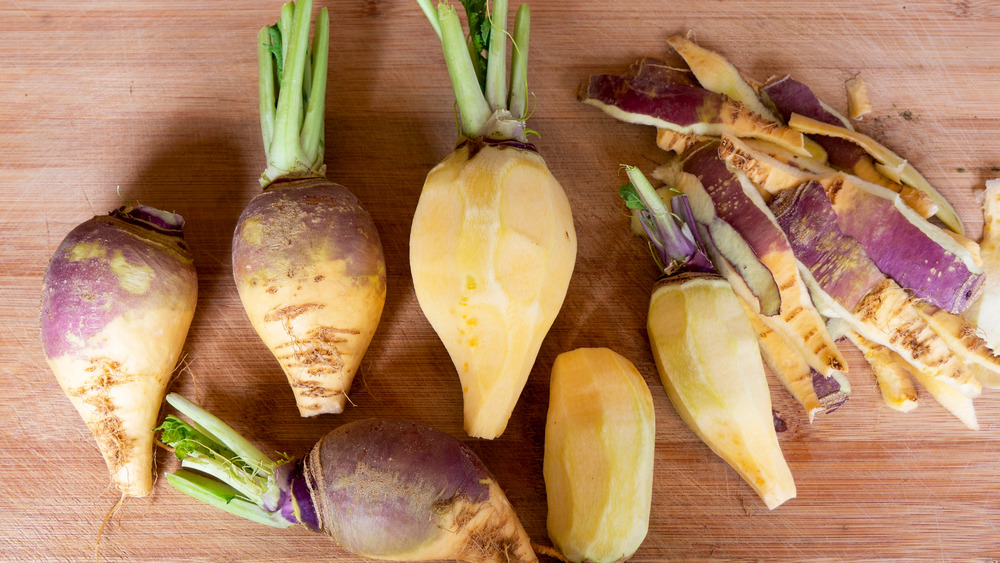What Is Rutabaga And How Do You Use It?
Rutabaga is a peculiar-looking, bulbous root vegetable that's not especially photogenic, but it is absolutely delicious.
MyRecipes notes that rutabaga originated in the 17th century, "a hybrid between a turnip and a wild cabbage." In The New Yorker, Helen Rosner waxes poetic, writing that rutabagas are "dense and sweetly earthy, a spheroid that can grow to the size of a human head, with a mottled, brown-and-white surface and a buttery, yellow interior." Rutabagas are rather large, tend to be yellow or purple tinged, and are very round. They have a knobby, gnarled top that almost looks like the root of a tree. They are also sometimes calls "swedes." They grow in cool climates. Their flesh is mild, slightly sweet, and somewhat bitter. They take on a potato-like consistency when cooked.
Rutabaga comes from the cabbage family, according to The Spruce Eats. "Rutabaga are thought to have originated in Bohemia in the Czech Republic, but they have been grown in the US since the 1800s," according to We Are Chefs. There are multiple varieties of the root vegetable. They have a very waxy skin.
Mashed rutabaga is delicious, and it's also delicious cubed and roasted wit some olive oil, salt, and pepper. They're also delicious served as a puree, in soup, or as "french fries." Their leaves can also be cooked, similar to radish or carrot tops/greens. Rutabaga also pairs very well with other vegetables, and even some fruits.
How should I use rutabaga?
It's excellent when cooked as a gratin, with cream and lots of cheese. They also stand up well to sweeter flavors, so roasting rutabaga with maple syrup can be an excellent autumnal side dish. You can also eat rutabaga raw or thinly slice it before cooking, enjoying as you would pasta, in the same vein as zucchini noodles. In Taste Cooking, Alicia Kennedy states that rutabaga is an excellent plant-based centerpiece for a vegan meal, noting that it's large, substantial, and hearty enough to stand up to a variety of cooking techniques and flavors. In addition, Smithsonian Magazine notes a Finnish rutabaga dish called lanttulaatikko, which is a casserole that involves "milk, eggs, nutmeg, molasses, and bread crumbs."
Rutabaga is also super nutritious – MyRecipes notes that they are "high in vitamin C and fiber" and that they're also much lower in carbs than potatoes, so making a mashed rutabaga (or even half rutabaga, half potato) can be preferable for anyone looking to eschew any extraneous carbs. They're high in vitamin c, low in calories, and high in potassium and fiber, according to The Mom 100. Lastly, Healthline also notes that rutabagas are high in antioxidants, help to prevent premature aging, foster digestive health, and help with weight loss.
Clearly, rutabaga is no slouch when it comes to nutritional benefits, and when you also consider its delicious flavor and versatility, perhaps you'll be motivated to pick up one of these large, shapely root vegetables when you're next doing a food shopping run.

